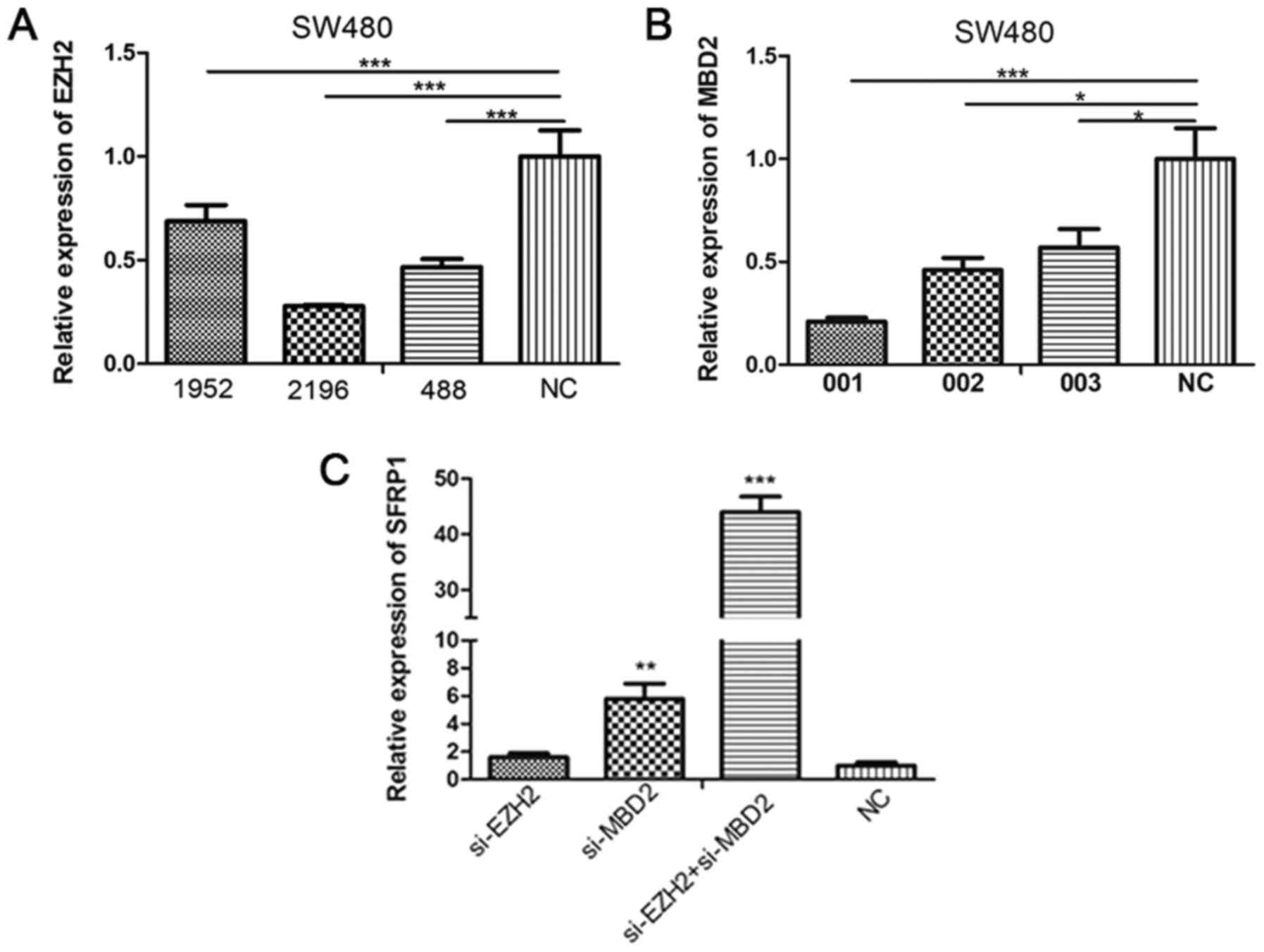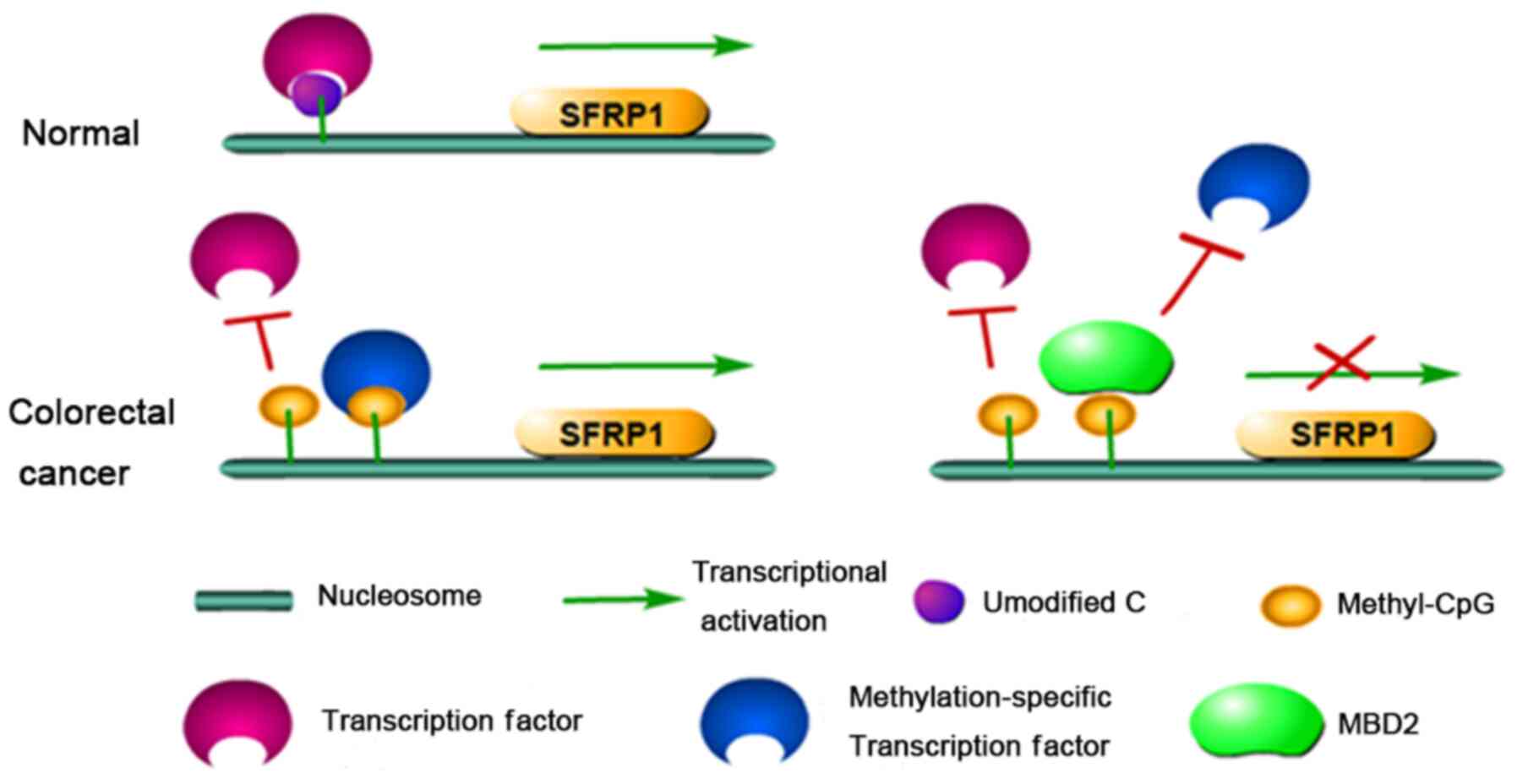|
1
|
Siegel R, Desantis C and Jemal A:
Colorectal cancer statistics, 2014. CA Cancer J Clin. 64:104–117.
2014.PubMed/NCBI View Article : Google Scholar
|
|
2
|
Vermeulen L, De Sousa E Melo F, van der
Heijden M, Cameron K, de Jong JH, Borovski T, Tuynman JB, Todaro M,
Merz C, Rodermond H, et al: Wnt activity defines colon cancer stem
cells and is regulated by the microenvironment. Nat Cell Biol.
12:468–476. 2010.PubMed/NCBI View
Article : Google Scholar
|
|
3
|
Jensen M, Hoerndli FJ, Brockie PJ, Wang R,
Johnson E, Maxfield D, Francis MM, Madsen DM and Maricq AV: Wnt
signaling regulates acetylcholine receptor translocation and
synaptic plasticity in the adult nervous system. Cell. 149:173–187.
2012.PubMed/NCBI View Article : Google Scholar
|
|
4
|
Lv C, Li F, Li X, Tian Y, Zhang Y, Sheng
X, Song Y, Meng Q, Yuan S, Luan L, et al: MiR-31 promotes mammary
stem cell expansion and breast tumorigenesis by suppressing Wnt
signaling antagonists. Nat Commun. 8(1036)2017.PubMed/NCBI View Article : Google Scholar
|
|
5
|
Russell JO and Monga SS: Wnt/β-catenin
signaling in liver development, homeostasis, and pathobiology. Annu
Rev Pathol. 13:351–378. 2018.PubMed/NCBI View Article : Google Scholar
|
|
6
|
Tammela T, Sanchez-Rivera FJ, Cetinbas NM,
Wu K, Joshi NS, Helenius K, Park Y, Azimi R, Kerper NR, Wesselhoeft
RA, et al: A Wnt-producing niche drives proliferative potential and
progression in lung adenocarcinoma. Nature. 545:355–359.
2017.PubMed/NCBI View Article : Google Scholar
|
|
7
|
Klaus A and Birchmeier W: Wnt signalling
and its impact on development and cancer. Nat Rev Cancer.
8:387–398. 2008.PubMed/NCBI View
Article : Google Scholar
|
|
8
|
Rattner A, Hsieh JC, Smallwood PM, Gilbert
DJ, Copeland NG, Jenkins NA and Nathans J: A family of secreted
proteins contains homology to the cysteine-rich ligand-binding
domain of frizzled receptors. Natl Acad Sci USA. 94:2859–2863.
1997.PubMed/NCBI View Article : Google Scholar
|
|
9
|
Suzuki H, Watkins DN, Jair KW, Schuebel
KE, Markowitz SD, Chen WD, Pretlow TP, Yang B, Akiyama Y, Van
Engeland M, et al: Epigenetic inactivation of SFRP genes allows
constitutive WNT signaling in colorectal cancer. Nat Genet.
36:417–422. 2004.PubMed/NCBI View
Article : Google Scholar
|
|
10
|
Elzi DJ, Song MH, Hakala K, Weintraub ST
and Shiio Y: Wnt antagonist SFRP1 functions as a secreted mediator
of senescence. Mol Cell Biol. 32:4388–4399. 2012.PubMed/NCBI View Article : Google Scholar
|
|
11
|
Qi J, Zhu YQ, Luo J and Tao WH:
Hypermethylation and expression regulation of secreted
frizzled-related protein genes in colorectal tumor. World J
Gastroenterol. 12:7113–7117. 2006.PubMed/NCBI View Article : Google Scholar
|
|
12
|
Margueron R and Reinberg D: Chromatin
structure and the inheritance of epigenetic information. Nat Rev
Genet. 11:285–296. 2010.PubMed/NCBI View
Article : Google Scholar
|
|
13
|
Allis CD and Jenuwein T: The molecular
hallmarks of epigenetic control. Nat Rev Genet. 17:487–500.
2016.PubMed/NCBI View Article : Google Scholar
|
|
14
|
Hughes TR and Lambert SA: Transcription
factors read epigenetics. Science. 356:489–490. 2017.PubMed/NCBI View Article : Google Scholar
|
|
15
|
Riising EM, Comet I, Leblanc B, Wu X,
Johansen JV and Helin K: Gene silencing triggers polycomb
repressive complex 2 recruitment to CpG islands genome wide. Mol
Cell. 55:347–360. 2014.PubMed/NCBI View Article : Google Scholar
|
|
16
|
Pan H, Bilinovich SM, Kaur P, Riehn R,
Wang H and Williams DC Jr: CpG and methylation-dependent DNA
binding and dynamics of the methylcytosine binding domain 2 protein
at the single-molecule level. Nucleic Acids Res. 45:9164–9177.
2017.PubMed/NCBI View Article : Google Scholar
|
|
17
|
Negishi M, Saraya A, Miyagi S, Nagao K,
Inagaki Y, Nishikawa M, Tajima S, Koseki H, Tsuda H, Takasaki Y, et
al: Bmi1 cooperates with Dnmt1-associated protein 1 in gene
silencing. Biochem Biophys Res Commun. 353:992–998. 2007.PubMed/NCBI View Article : Google Scholar
|
|
18
|
Wood KH and Zhou Z: Emerging molecular and
biological functions of MBD2, a reader of DNA methylation. Fron
Genet. 7(93)2016.PubMed/NCBI View Article : Google Scholar
|
|
19
|
Vire E, Brenner C, Deplus R, Blanchon L,
Fraga M, Didelot C, Morey L, Van Eynde A, Bernard D, Vanderwinden
JM, et al: The Polycomb group protein EZH2 directly controls DNA
methylation. Nature. 439:871–874. 2006.PubMed/NCBI View Article : Google Scholar
|
|
20
|
Ahmed D, Eide PW, Eilertsen IA, Danielsen
SA, Eknæs M, Hektoen M, Lind GE and Lothe RA: Epigenetic and
genetic features of 24 colon cancer cell lines. Oncogenesis.
2(e71)2013.PubMed/NCBI View Article : Google Scholar
|
|
21
|
Bai J, Xu J, Zhao J and Zhang R: lncRNA
SNHG1 cooperated with miR-497/miR-195-5p to modify
epithelial-mesenchymal transition underlying colorectal cancer
exacerbation. J Cell Physiol. 235:1453–1468. 2020.PubMed/NCBI View Article : Google Scholar
|
|
22
|
Livak KJ and Schmittgen TD: Analysis of
relative gene expression data using real-time quantitative PCR and
the 2(-Delta Delta C(T)) method. Methods. 25:402–408.
2001.PubMed/NCBI View Article : Google Scholar
|
|
23
|
Cruciat CM and Niehrs C: Secreted and
transmembrane wnt inhibitors and activators. Cold Spring Harb
Perspect Biol. 5(a015081)2013.PubMed/NCBI View Article : Google Scholar
|
|
24
|
Yu J, Xie Y, Li M, Zhou F, Zhong Z, Liu Y,
Wang F and Qi J: Association between SFRP promoter hypermethylation
and different types of cancer: A systematic review and
meta-analysis. Oncol Lett. 18:3481–3492. 2019.PubMed/NCBI View Article : Google Scholar
|
|
25
|
Tatematsu KI, Yamazaki T and Ishikawa F:
MBD2-MBD3 complex binds to hemi-methylated DNA and forms a complex
containing DNMT1 at the replication foci in late S phase. Genes
Cells. 5:677–688. 2000.PubMed/NCBI View Article : Google Scholar
|
|
26
|
Jones PA and Taylor SM: Cellular
differentiation, cytidine analogues and DNA methylation. Cell.
20:85–93. 1980.PubMed/NCBI View Article : Google Scholar
|
|
27
|
Cramer JM, Scarsdale JN, Walavalkar NM,
Buchwald WA, Ginder GD and Williams DC Jr: Probing the dynamic
distribution of bound states for methylcytosine-binding domains on
DNA. J Biol Chem. 289:1294–1302. 2014.PubMed/NCBI View Article : Google Scholar
|
|
28
|
Wood KH and Zhou Z: Emerging molecular and
biological functions of MBD2, a reader of DNA methylation. Front
Genet. 7(93)2016.PubMed/NCBI View Article : Google Scholar
|
|
29
|
Quan H, Zhou F, Nie D, Chen Q, Cai X, Shan
X, Zhou Z, Chen K, Huang A, Li S and Tang N: Hepatitis C virus core
protein epigenetically silences SFRP1 and enhances HCC
aggressiveness by inducing epithelial-mesenchymal transition.
Oncogene. 33:2826–2835. 2014.PubMed/NCBI View Article : Google Scholar
|
|
30
|
Desai MA, Webb HD, Sinanan LM, Scarsdale
JN, Walavalkar NM, Ginder GD and Williams DC Jr: An intrinsically
disordered region of methyl-CpG binding domain protein 2 (MBD2)
recruits the histone deacetylase core of the NuRD complex. Nucleic
Acids Res. 43:3100–3113. 2015.PubMed/NCBI View Article : Google Scholar
|
|
31
|
Berger J and Bird A: Role of MBD2 in gene
regulation and tumorigenesis. Biochem Soc Trans. 33:1537–1540.
2005.PubMed/NCBI View Article : Google Scholar
|
|
32
|
Tuğrul M, Paixão T, Barton NH and Tkačik
G: Dynamics of transcription factor binding site evolution. PLoS
Genet. 11(e1005639)2015.PubMed/NCBI View Article : Google Scholar
|
|
33
|
Liu Y, Toh H, Sasaki H, Zhang X and Cheng
X: An atomic model of Zfp57 recognition of CpG methylation within a
specific DNA sequence. Genes Dev. 26:2374–2379. 2012.PubMed/NCBI View Article : Google Scholar
|
|
34
|
Yin Y, Morgunova E, Jolma A, Kaasinen E,
Sahu B, Khund-Sayeed S, Das PK, Kivioja T, Dave K, Zhong F, et al:
Impact of cytosine methylation on DNA binding specificities of
human transcription factors. Science. 356(eaaj2239)2017.PubMed/NCBI View Article : Google Scholar
|
















